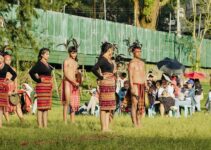Hey there! Boosting economic growth in indigenous communities is like planting seeds in fertile soil—full of potential and opportunity. By implementing sustainable strategies and fostering entrepreneurship, we can cultivate thriving economies that benefit everyone. Access to infrastructure and resources, along with collaborative partnerships, are key to fueling this growth. Let's explore the ways in which we can work together to create lasting economic prosperity in indigenous communities.
Key Takeaways
- Limited access to job markets and inadequate educational resources are major challenges faced by indigenous communities in achieving economic growth.
- Strategies for sustainable economic development in indigenous communities include community empowerment and local ownership, sustainable practices and responsible resource management, attracting environmentally conscious consumers and businesses, and preserving cultural and natural heritage.
- Entrepreneurship and indigenous business opportunities can be leveraged by tapping into unique cultural assets, providing tailored business support, access to financial resources, mentorship programs, and preservation and revitalization of traditional crafts, knowledge, and practices.
- Infrastructure development and improving access to economic resources are crucial for boosting economic growth in indigenous communities, including enhancing transportation networks, reducing isolation and opening up new economic opportunities, and upgrading transportation infrastructure to improve access to markets and attract investment.
Economic Challenges in Indigenous Communities
Addressing economic challenges in indigenous communities requires understanding the unique barriers and opportunities they face. When it comes to employment opportunities, indigenous communities often encounter limited access to job markets due to geographic isolation and inadequate educational resources. Many community members struggle to find stable, well-paying jobs, perpetuating cycles of poverty. Additionally, financial inclusion remains a significant hurdle, with limited access to banking services and capital for entrepreneurial ventures. This lack of access to financial resources hinders the potential for economic growth and self-sufficiency.
To overcome these challenges, it's essential to create tailored solutions that address the specific needs of indigenous communities. This may involve implementing programs that provide specialized job training, promoting entrepreneurship, and fostering partnerships with businesses to increase employment opportunities within the communities. Moreover, initiatives aimed at improving financial literacy and expanding access to banking services can enhance financial inclusion, empowering community members to manage their finances effectively and invest in their futures. By prioritizing these efforts, we can work towards creating a more equitable and prosperous economic landscape for indigenous communities.
Government Policies and Indigenous Economies
To boost economic growth in indigenous communities, you need to understand the impact of government policies on their economies. Government support plays a crucial role in shaping the economic landscape of indigenous communities. Policies that prioritize infrastructure development, access to education, and healthcare services can significantly boost economic growth. Additionally, government initiatives aimed at fostering entrepreneurship and small business development within indigenous communities can create sustainable economic opportunities. Furthermore, preserving and promoting indigenous cultures through policies that support traditional practices and arts can contribute to economic growth while maintaining cultural preservation.
Government policies that focus on cultural preservation not only safeguard the unique heritage of indigenous communities but also create opportunities for economic development through tourism and cultural exchange programs. By recognizing the value of indigenous knowledge and traditions, governments can support initiatives that showcase indigenous art, crafts, and cultural experiences, fostering economic growth while preserving the rich heritage of these communities.
Understanding the impact of government policies on indigenous economies is crucial for implementing effective strategies for sustainable economic development. Now, let's explore key strategies that can drive long-term economic growth and prosperity in indigenous communities.
Strategies for Sustainable Economic Development
You must consider the importance of implementing targeted strategies to foster sustainable economic development within indigenous communities, building upon the impact of government policies on their economies. Community empowerment plays a pivotal role in sustainable economic development. Encouraging local ownership and decision-making processes empowers indigenous communities to shape their economic future. It fosters a sense of responsibility and commitment to the sustainable practices necessary for long-term economic growth. Sustainable practices, such as environmentally friendly initiatives and responsible resource management, not only preserve the natural environment but also ensure the longevity of economic activities within indigenous communities. These practices can create a unique selling point for indigenous products and services, attracting environmentally conscious consumers and businesses. By integrating sustainable practices into economic development strategies, indigenous communities can build resilient and self-sufficient economies while preserving their cultural and natural heritage. Transitioning into the subsequent section about 'entrepreneurship and indigenous business opportunities', it is imperative to explore how these sustainable strategies can create a fertile ground for entrepreneurial endeavors and indigenous business growth.
Entrepreneurship and Indigenous Business Opportunities
Continuing from the previous subtopic, it is essential to understand how sustainable strategies can create a fertile ground for entrepreneurial endeavors and indigenous business growth. Indigenous entrepreneurship holds immense potential for fostering economic development within indigenous communities. By embracing business innovation, indigenous entrepreneurs can tap into their unique cultural assets, fostering economic growth while preserving their heritage. Encouraging indigenous entrepreneurship involves providing access to tailored business support, financial resources, and mentorship programs. These initiatives can empower indigenous individuals to establish and expand their businesses, thereby contributing to the overall economic prosperity of their communities. Additionally, promoting indigenous-owned businesses can lead to the preservation and revitalization of traditional crafts, knowledge, and practices, adding cultural value to the economic landscape. Recognizing and supporting the entrepreneurial spirit within indigenous communities is crucial for creating sustainable economic opportunities and fostering self-reliance. By nurturing a supportive environment for indigenous entrepreneurship and business innovation, it becomes possible to build a more inclusive and prosperous economic future for indigenous communities.
Infrastructure and Access to Economic Resources
You can enhance economic growth in Indigenous communities by improving transportation networks and market connectivity. By investing in infrastructure, you can create better access to economic resources, leading to increased opportunities for businesses and individuals. These improvements can help foster economic development and prosperity within Indigenous communities.
Improving Transportation Networks
To effectively boost economic growth in Indigenous communities, improving transportation networks through infrastructure upgrades and increased access to economic resources is crucial.
- Rural Connectivity
- Enhancing road, rail, and air connectivity in remote Indigenous areas is essential for facilitating the movement of goods and people, reducing isolation, and opening up new economic opportunities.
- Upgrading transportation infrastructure, such as roads and bridges, can significantly reduce transportation costs, improve access to markets, and attract investment in these regions.
Improving transportation networks not only enhances the movement of goods and services but also creates opportunities for Indigenous communities to engage in economic activities beyond their immediate vicinity. This sets the stage for the subsequent section about 'enhancing market connectivity'.
Enhancing Market Connectivity
Enhancing market connectivity in Indigenous communities requires expanding access to economic resources and infrastructure, allowing for greater participation in regional and national economies. To achieve this, it is crucial to focus on market expansion and strengthening trade networks. By improving infrastructure such as roads, bridges, and ports, Indigenous communities can enhance their connectivity to regional and national markets, facilitating the movement of goods and services. Additionally, increasing access to economic resources like financial services and technology is essential for Indigenous entrepreneurs to thrive in the marketplace. Here's a table outlining key steps for enhancing market connectivity:
| Key Steps | Description |
|---|---|
| Infrastructure Development | Build and upgrade roads, bridges, and ports |
| Market Access | Improve access to financial services and markets |
| Trade Network Strengthening | Enhance connectivity to regional and national markets |
| Technology Integration | Integrate technology for efficient trade processes |
Collaborative Partnerships for Community Economic Growth
Collaborative partnerships play a crucial role in driving economic growth within indigenous communities. These partnerships facilitate capacity building and community engagement, allowing for the development of sustainable economic initiatives. By working together with various stakeholders, indigenous communities can tap into a diverse range of expertise and resources, leading to more effective and impactful economic development strategies.
- Capacity Building and Community Engagement:
- Fostering collaborative partnerships enables the sharing of knowledge and skills, empowering community members to actively participate in economic activities. This involvement not only enhances the overall capacity of the community but also fosters a sense of ownership and pride in the initiatives undertaken.
- Engaging with community members ensures that their voices are heard and their needs are taken into account, leading to more inclusive and culturally appropriate economic development efforts.
- Resource Allocation and Investment Opportunities:
- Collaborative partnerships open up avenues for accessing funding, resources, and technical support, which are vital for implementing economic growth projects. This can include securing investment opportunities, grants, and other forms of financial assistance that may not have been accessible otherwise.
- By pooling resources and expertise through partnerships, indigenous communities can leverage their collective strengths to attract investment and create sustainable economic opportunities for the future.
Frequently Asked Questions
What Specific Government Policies Have Been Successful in Boosting Economic Growth in Indigenous Communities?
Government incentives and community engagement have been successful in boosting economic growth in indigenous communities. By providing targeted support and fostering collaboration with local leaders, the government has been able to create opportunities for economic development. These policies have led to increased investment, job creation, and overall prosperity within indigenous communities. Through these efforts, the government has played a vital role in driving positive economic outcomes for indigenous populations.
How Can Indigenous Communities Overcome the Barriers to Accessing Economic Resources and Infrastructure?
To overcome the barriers to accessing economic resources and infrastructure, you must first identify the root causes of the challenges faced. By understanding the specific obstacles, you can strategize and collaborate to create targeted solutions. Accessing resources, whether financial or educational, is crucial for sustainable growth. Additionally, addressing infrastructure barriers, such as transportation and technology, will pave the way for increased economic opportunities within indigenous communities.
What Are Some Unique Entrepreneurship Opportunities That Are Specific to Indigenous Communities?
When considering unique entrepreneurship opportunities in indigenous communities, cultural tourism and traditional crafts offer avenues for economic growth. Social enterprise and land stewardship also present distinctive prospects. These opportunities align with the rich cultural heritage and environmental knowledge of indigenous communities, providing platforms for sustainable economic development. Leveraging these unique strengths can not only boost economic growth but also preserve and promote indigenous traditions and values.
How Have Collaborative Partnerships Between Indigenous Communities and External Organizations Contributed to Economic Growth?
Collaborative partnerships between indigenous communities and external organizations have been pivotal in driving economic growth. They've fostered economic empowerment by pooling resources, expertise, and networks. The impact of these partnerships is substantial, propelling businesses, creating jobs, and fostering sustainable development. By leveraging the strengths of both parties, these collaborations have unleashed a wave of economic opportunities, benefiting not only the communities involved but also the broader economy.
What Are Some Innovative Strategies for Sustainable Economic Development That Have Been Implemented in Indigenous Communities?
To achieve sustainable development, innovative strategies like community engagement and capacity building are crucial. Implementing these approaches in indigenous communities can lead to long-term economic growth and stability. By empowering local residents and fostering collaboration with external partners, these communities can develop self-sustaining economies. This proactive approach can help ensure that economic development is not only impactful in the short term, but also has lasting positive effects for future generations.
Conclusion
You've learned about the economic challenges facing indigenous communities and the importance of government policies and sustainable development strategies. By supporting entrepreneurship and business opportunities, improving infrastructure, and fostering collaborative partnerships, these communities can thrive. For example, the Maori people of New Zealand have successfully utilized their cultural heritage to create sustainable tourism ventures, bringing economic growth to their community while preserving their traditions. It's clear that with the right support, indigenous communities can boost their economic growth.



